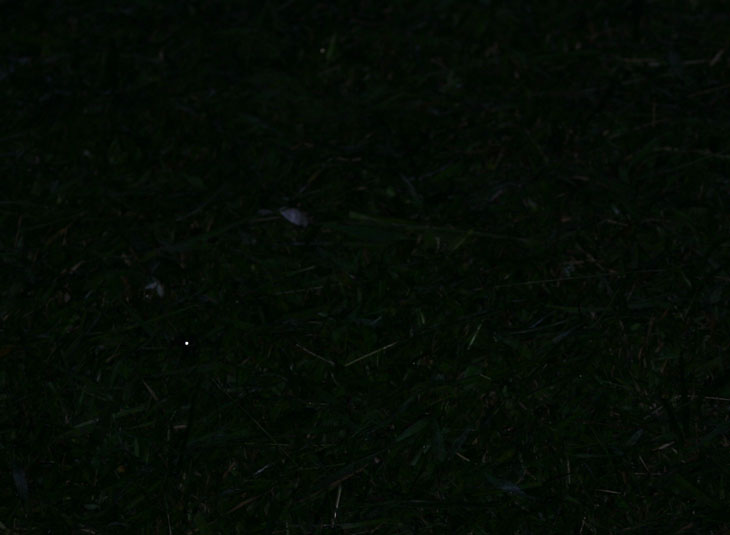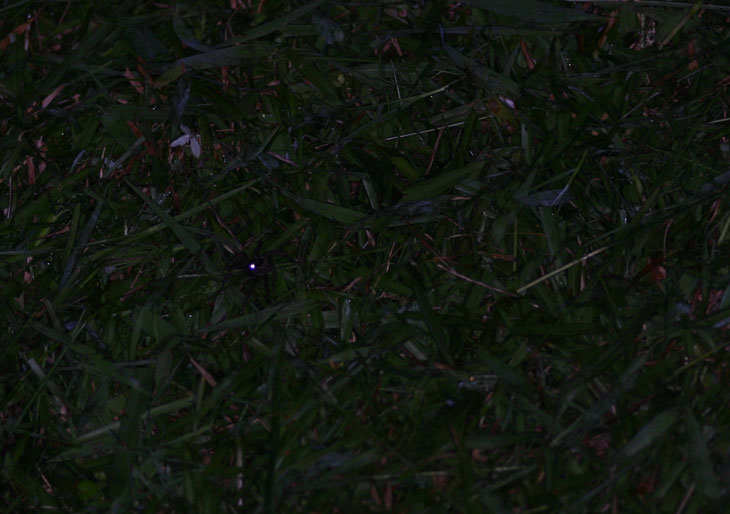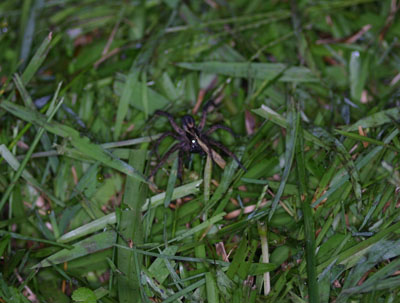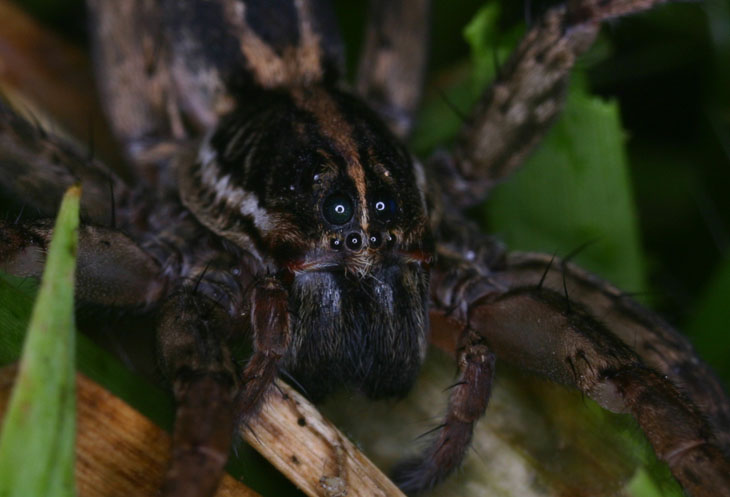This is a revisit of a post from a few years ago, partially because I always wanted to tackle the images better, and partially because this is the season for it. But at the same time, this post is aimed in part at the people with a fear of spiders, because it just might be a factor in getting over this phobia.
If you go outside in the early evening, just as it’s gotten fully dark, and hold a strong flashlight up as close to your eyes as you can while aiming it around the yard, you stand a pretty good chance of seeing something like this, a bright star in your lawn:

This pic doesn’t even do it justice, because the color is a distinctive blue-green. If you’ve waited too long and the dew has formed, you can differentiate it because dew will go through a color shift with a slight change in position, often producing an orange reflection, while your target does not change color (but may disappear with the shift.) Keep your eyes and light on it as you get closer.

Eventually, it will disappear, but not before you’re close enough to know the position where you lost sight of it. Keep going. What you’re seeing, if you’ve gotten the right subject, are the peculiar properties of spider eyes, which are remarkably reflective. But they require a very narrow angle between light source and your eye, so your flashlight (bright LED lights do this the best) needs to be as close to your eye as possible, and the headlamps that shine from your forehead work very well.
 I didn’t quite have focus nailed for this one, so I’m not showing it any larger, and typically by this distance you would have stopped seeing the reflection. The various species of wolf spiders are the easiest to find, because they tend to be very active at night and their eyes possess this characteristic the strongest that I’ve found, able to be seen from several meters away, but I’ve produced the effect from many other species as well, including black widows. It’s just the structure of their eyes. If you’re creeped out by spiders, this can be a bit sobering, as you realize how many might be found in your lawn; at the same time, it’s always been like this, and no harm came to you, right? Most spiders are actually very shy and avoid any kind of contact – I often have to be cautious in my approach for photos because many species try to hide. Wolf spiders are more mellow, and often don’t care how close you get, nor are they the least aggressive. This little exercise is actually a great way to start getting over a fear of spiders, since you can see for yourself (at whatever distance you like) how little they affect anything. Then, if by chance they run across you, you can shrug it off as easily as you might a bird flying through the yard.
I didn’t quite have focus nailed for this one, so I’m not showing it any larger, and typically by this distance you would have stopped seeing the reflection. The various species of wolf spiders are the easiest to find, because they tend to be very active at night and their eyes possess this characteristic the strongest that I’ve found, able to be seen from several meters away, but I’ve produced the effect from many other species as well, including black widows. It’s just the structure of their eyes. If you’re creeped out by spiders, this can be a bit sobering, as you realize how many might be found in your lawn; at the same time, it’s always been like this, and no harm came to you, right? Most spiders are actually very shy and avoid any kind of contact – I often have to be cautious in my approach for photos because many species try to hide. Wolf spiders are more mellow, and often don’t care how close you get, nor are they the least aggressive. This little exercise is actually a great way to start getting over a fear of spiders, since you can see for yourself (at whatever distance you like) how little they affect anything. Then, if by chance they run across you, you can shrug it off as easily as you might a bird flying through the yard.

Even this close, the lighting method I used produced a faint vestige of the reflection from one eye – I think, anyway. I’ve seen this in my images numerous times before, but have never determined if it’s an artifact of my lighting angle or an actual physical trait of the spider subjects, like how snake eyes turn cloudy and bluish when they’re coming due for a molt. And yes, I’d recently mowed an overgrown lawn, so grass clippings were everywhere, but this reduced the dew and made the spiders easier to find.
Now once again, here’s why ringflashes aren’t the best lighting method for macro photography:

You have to appreciate the expression it seemed to create, especially since there’s even a suggestion of raised eyebrows, but overall, it’s not an ideal image because of that effect. I was using the ringflash specifically to produce the eye reflection photos, though, because it’s the easiest way to get a light source as close to the lens as possible. One of these days I’ll experiment with an angled piece of glass in front of the lens, reflecting a light source perpendicular to the lens axis. The light will be able to go almost straight to the subject from the lens center, bouncing back and through the glass to the lens and shutter – look at the diagrams of a teleprompter to get the idea. I do know this will reduce contrast a bit and I’d have to be meticulous about preventing stray reflections, so it’s one of those projects that will likely wait for a serious demand.
Now, I mentioned above about conditioning oneself to get over a fear of spiders, and I can imagine the scoffing. But I offer myself as an example, because I grew up with a fear of spiders, seriously creeped out by them, and in fact there’s still a vestige of it hiding just under the surface. Over time, I got more used to arachnids, and let the rational part of my thinking processes overcome the part conditioned somewhere in my childhood – you know, where I developed emotional responses based on wildly misleading information within an impressionable, naïve mind. And yes, it helps to remind yourself that this is how it happened, rather than trying to justify a phobia. Children in certain areas of Central and South America hunt tarantulas for food, demonstrating pretty distinctly that we’re not born with a fear of spiders (or snakes, or dogs, or commitment… wait; not sure about that last bit.) It can be overcome, with less effort than you might imagine, and seeing how innocuous they are helps a lot.

While biking down a sidewalk under the trees late one summer night, I rode through a very large orb web, feeling the strands distinctly from my wrists all the way to my chin. Had I been inclined to panic I would have crashed the bike and had a long walk back with whatever injuries, but I’d overcome the phobia by this time and merely cursed, continuing to ride until I got under a streetlight. There, I brushed away the copious webbing and the occupant of the web, the diameter of a dime, who had crouched fearfully on my shoulder with no way to find safety. I wasn’t bitten, and in fact am not sure I’ve ever been bitten – even a suspected black widow bite has now been thrown into serious doubt. I’ve walked through more webs than you can imagine (my guess is over a hundred a year, from doing nature photography out in the woods,) plus I’m always poking around in ideal habitats. There’s just no reason to be afraid of spiders. Even the strongly venomous ones present far less risk than driving on a road daily, because the chances of encountering one are minuscule, and of getting bitten smaller still.
So if it’s necessary, tell your emotions that the rational mind now has control, grab the flashlight, and go see if you can spot the phenomenon, the next night that permits it. It’s really a pretty cool thing to see.




















































